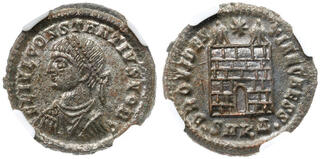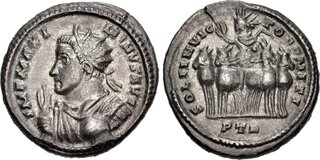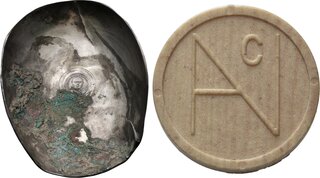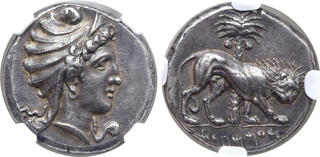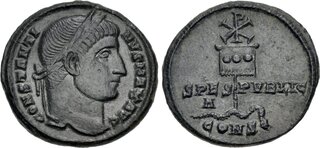Match 1:
Match 2:
Match 3:
Match 4:
Match 5:
| Classical Numismatic Group > Auction 126 | Auction date: 28 May 2024 |
| Lot number: 1029 Price realized: This lot is for sale in an upcoming auction - Bid on this lot  | |
| Lot description: Umayyad Caliphate. temp. 'Abd al-Malik ibn Marwan to 'Umar ibn Abd al-Aziz. AH 65-101 / AD 685-720. AV Solidus (16mm, 4.35 g, 6h). North Africa (Carthage) mint. Struck circa AH 79-90 (AD 698-710). NON ЄST dS NIS IPSЄ SOL CS ЄT NON ABЄII, crowned and draped Byzantine-style older and younger facing busts (modeled on Heraclius and Heraclius Constantine) / [...]NOΔNCI SIb ЄbNCIPIAS OΔЄI, modified cross potent, surmounted by globus and set on two steps. SICA 1 –; AGC I 9 (this coin illustrated); cf. Walker, Arab-Byzantine p. 55, HSA 1 and 145 (AV Semissis); cf. Album 115 (for similar issue with horizontal bar on steps). Iridescent toning, deposits in devices. Good VF. Unique. From the Family of Constantine Collection, assembled with guidance by Roland Michel, Geneva. Ex Triton VI (13 January 2003) lot 1189; Dr. Anton C. R. Dreesmann Collection (Part II, Spink 144, 13 July 2000), lot 846, purchased from J. Schulman, 14 November 1967. The Muslim conquest of North Africa began during the caliphate of Mu'awiya (AH 41-60 / AD 661-680). Qayrawan, the capital of the new Umayyad province of Ifriqiya, was founded by the general 'Uqba b. Nafi' in AH 50 (AD 670). The Arab conquest, however, was met with determined resistance, from the Berbers as well as Byzantine forces, and the great city of Carthage remained a Byzantine stronghold in North Africa for a quarter of a century. It was only in AH 76 (AD 695) that the city first fell to the Arabs when the inhabitants surrendered to the besieging forces of Hassan b. al-Nu'man. While many of the wealthier inhabitants fled to Italy, Greece and Spain, the rest of the city's population offered no resistance and Hassan occupied Carthage without much bloodshed. Judging his position secure, Hassan constructed chains across the city's harbor to deter the Byzantines from launching a counter-attack by sea, and then departed with most of his troops to meet the threat of the Berbers to the west. Hassan's faith in these chains proved misplaced. The Byzantine emperor Leontius sent a strong naval force under John the Patrician to retake Carthage. John equipped his largest ships with specially reinforced hulls, allowing him to smash through the chains and land safely in the city's harbor. Outnumbered, the Arab garrison was no match for John's Sicilian and Gothic troops. John quickly retook the city, and the defenders withdrew to Qayrawan. But the Byzantines were hopelessly slow to support John's initial success, so that Hassan reappeared before the walls of Carthage with a fresh army before John's reinforcements had even left the port of Constantinople. Now it was John's turn to find himself helpless in the face of a far superior force, and he had little option but to withdraw. The Byzantine army held the walls long enough to allow a hasty but relatively orderly retreat; Hassan reoccupied Carthage in AH 79 (AD 698). Fearing the consequences of having to report their failure to Leontius, John's troops mutinied, killing John and proclaiming one of their number, Apsimar, as emperor. Apsimar's forces entered Constantinople later in AD 698, deposing and mutilating Leontius, and leaving Apsimar to rule as Tiberius III. It is possible to trace the course of these momentous events in the coinage record. The Byzantine mint at Carthage was evidently still active in AH 76, since Carthaginian solidi are known dated to the tenth year of the reign of Justinian II (MIB 18b), so when the city first surrendered to Hassan b. al-Nu'man the Arabs would have taken control of an operational Byzantine mint for solidi. This in itself would have been a highly significant development, because there had been no active gold mint in any of the Byzantine provinces which the Arabs had previously conquered, leaving them dependent on imported solidi to maintain coinage stocks. Thus once Carthage was securely in Muslim hands after the defeat of John in AH 79, the victorious Arabs began to strike gold coins of their own there, including the unique piece offered here. Although 'Abd al-Malik b. Marwan had introduced reformed, purely Islamic dinars at Damascus in AH 77 (AD 696/7), the Arabs continued to strike gold which copied earlier Byzantine types, recognizing the need to produce coins which would have been acceptable to the local population. Interestingly, they chose to copy an issue of Heraclius (AD 610-641) rather than the most recent solidi of Justinian II, probably to avoid the adverse political connotations of being seen to follow current Byzantine types; this preference for an older prototype is also seen on the Arab-Sasanian silver drachms struck in the Eastern Islamic territories, which usually bore the portrait of the long-dead Khusraw II rather than the last Sasanian ruler, Yazdigerd III. The new Arab solidi, which maintain the familiar 'globular' fabric of their Byzantine predecessors, were struck to the local Byzantine weight standard and issued in three denominations: solidus, semissis, and tremissis. They bear the familiar twin facing busts of Heraclius and Heraclius Constantine, largely unaltered except for the removal of all overtly Christian crosses, and a similarly 'de-Christianized' cross-on-steps on the reverse. The legends, written in abbreviated Latin rather than Arabic, are monotheistic rather than Islamic: the proclamation on the obverse of this coin that 'There is no God but God alone and He has no associate' would have been largely acceptable to Christians and Muslims alike. On virtually all surviving examples of this rare coinage, the modification of the cross-on-steps is used to indicate the denomination. Solidi and tremisses generally have the upper limb of the cross removed so that the shaft terminates in a T-bar, while semisses replace the cross with a globe. While there has been much scholarly debate over the symbolism of these changes, comparison with Byzantine prototypes suggests that the Arabs simply turned the Byzantine cross on each denomination upside-down, so that the base of the cross on the prototype became the top of the modified cross on the Arab adaptation. Thus the base of the cross potent on the tremisses becomes a T-bar set on a single step, the globe at the base of the cross potent on the semisses becomes a globe set atop a pole on two steps, and the cross-on-steps on the solidi also becomes a shaft surmounted by a T-bar set on three steps. The unique solidus offered here appears to be the only known solidus of this type which has a globe on top of the cross shaft instead of a T-bar. It does not fit with the system of denominations and types which the Arabs used for their Carthaginian coinage, and instead appears to look back to the modified cross-on-steps dinars with Arabic legends issued at Damascus before the introduction of the reformed gold coinage in AH 77 (AD 696/7). This in turn raises the tantalizing possibility that this unique piece might have been struck circa AH 76-77, during Hassan's first occupation of Carthage, and that Hassan simply followed current Damascus practice in striking solidi with a globe atop the cross-shaft on the reverse. It would only have been after the defeat and expulsion of John, when the Arabs had time to establish a structured denominational system for their Carthaginian gold coinage, that the decision would have been taken to use a T-bar instead of a globe on the solidi. Estimate: 20000 USD | 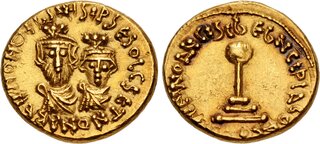 |


